Spotted wood owls share the same parental behaviour as most owls. Both parents perched on the same tree as the owlets, on the same perch or a distance away. The parents closed their eyes to sleep during the day but opened their eyes periodically. The parents had been seen to chase a juvenile goshawk that had wandered to their raintree home. In the evenings, the owlets engaged in a lot of auto-preening, wing stretching and walking on the tree branches while they explored their surroundings. The family frequently engaged each other in allopreening. The owlets engaged in more frequent head-bobbing (known as triangulation) as the weeks progressed. Owlets triangulate to judge distances and positions of objects as owls do not move their eyes in the sockets.
In the evenings, the male parent flew off to hunt food while the female parent stayed with the owlets on the tree. The family had been seen feeding on rats. The owls carried out gular fluttering on hot days in order to cool down. The owlets increased in size very quickly. The first owlet fledged on 19 February 2022 and the second owlet fledged on 21 February 2022 and they were about half the size of the parents. By 13 March 2022, the owlets were about the size of the parents. The youngsters could be seen gaining confidence in their tree branch walking, strenghtening their flight muscles by flapping their wings more frequently and with greater force exertion. The flight feathers (remiges) also grew longer with the passing weeks but the tail feathers (rectrices) were still shorter than those of the parents. By 11 March 2022, the owlets were seen flying from branch to branch. The owlets had facial discs which were lighter in colour than the parents. The brown edges of the facial discs were also not well-defined in the owlets. The owlets were also less snow white in colour.
On 13 March 2022, the author observed the male parent fly off at about 6.30 pm. The female parent stayed on the tree with the two owlets. At about 7.00 pm, the female parent let out a very loud hoot (ventriloquial effect) and flew off at about 7.15 pm. One owlet followed her and 2 minutes later the second owlet followed. The wing spans of the owlets were as long as the parents. The owls’ flights were silent and smooth, with very few flaps of the wings.
The owl family shifted to another tree within the park on 20 March 2022. On 24 March 2022, the owlets had feather patterns typical of spotted wood owls but down feathers were still discernible, especially on the heads. On 31 March 2022, only one owlet was seen in the company of the female parent. It is surmised that one owlet had met an unfortunate end. The parent birds will continue to feed the juveniles for several months more.
Additional note: On 2 April 2022, Christian Hut shared that the whole owl family had been seen allo-preening and auto-preening on a tree near Sungei Api Api. The birding community rejoices in this update. My conjecture is that the missing owlet missing (31 March 2022) is learning to hunt with the male parent.

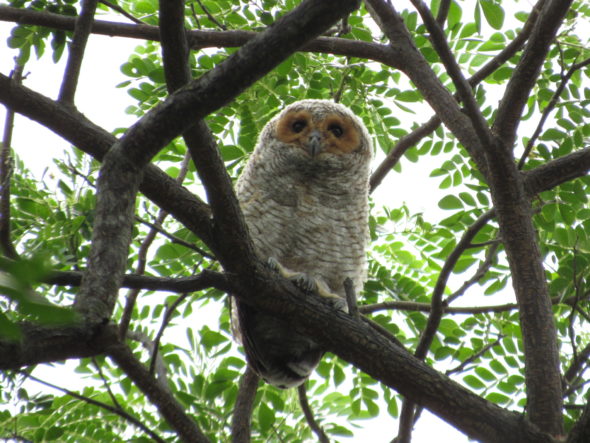


Video 1 shows owlet triangulating and walking on tree branch. It maintained balance by flapping its wings. 23 February 2022
Video 2 shows owlet triangulating, walking on tree branch and then preening itself (auto-preening). 23 February 2022
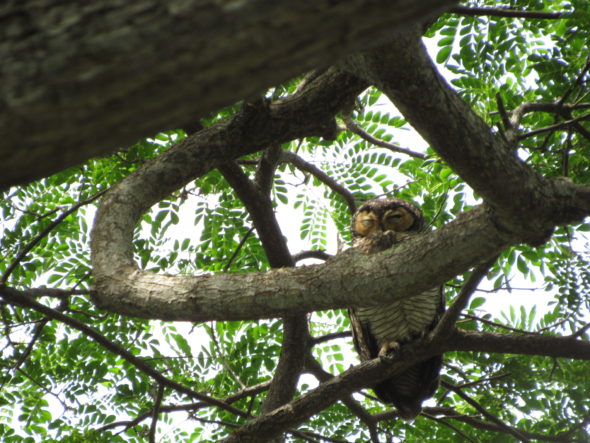
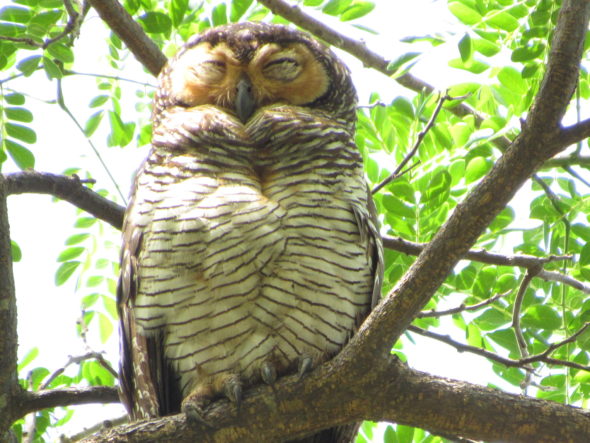
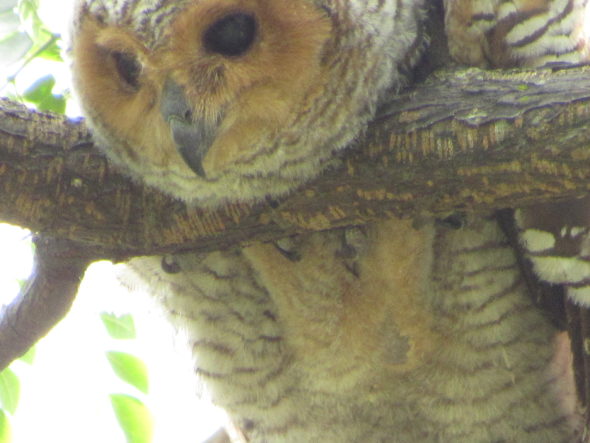
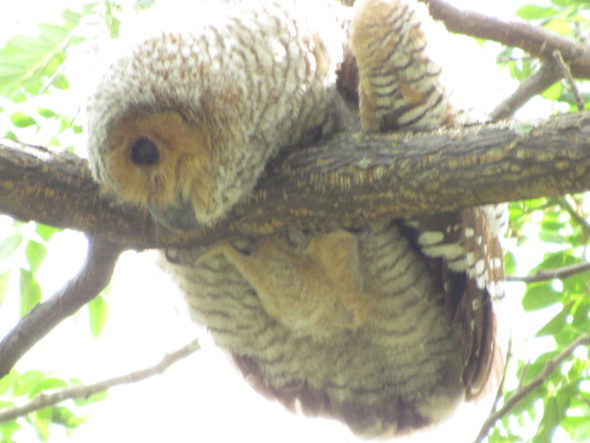

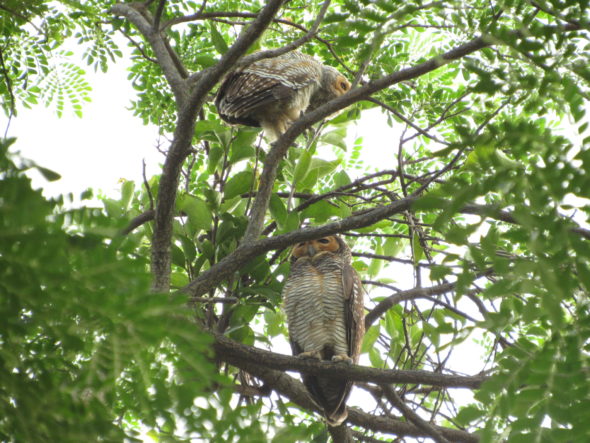
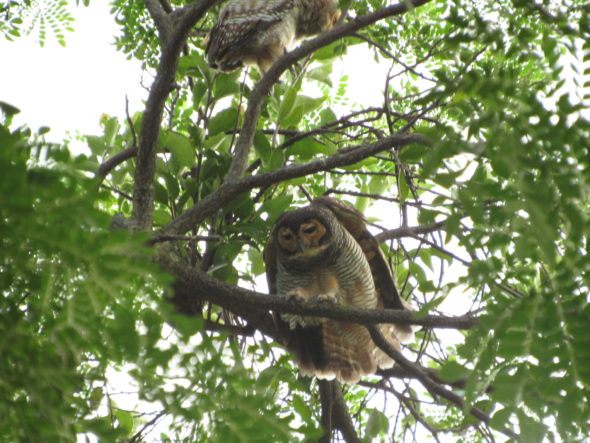

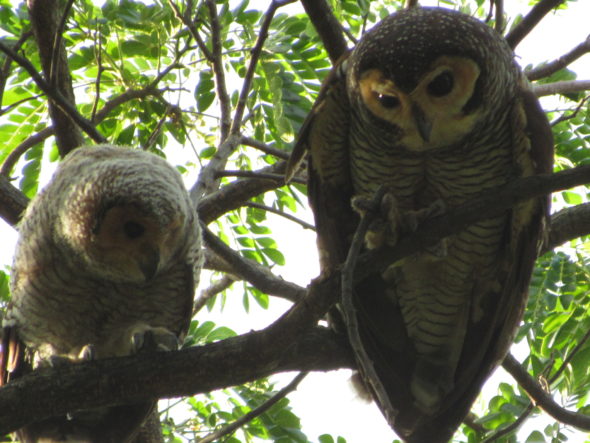
Video 3 shows the parent bird manipulating a twig. The owlet perched beside the parent bird, triangulated and was mesmerised by the huge crowd gathered below. 25 February 2022
Video 4 shows the owlet triangulating and then taking a short flight to perch beside its parent. 25 February 2022

Video 5 shows a lucky owlet getting a head preen from its parent and its sibling perched beside it removing the downy feathers on its back. There is close bonding between the family members. 13 March 2022
All photographs and videos are attributed to Wong Kais. All the photographs and videos are in the raw form and undertaken with a handheld camcorder.
The author of this post would like to register her thanks to the many true nature lovers who helped her locate and appreciate these wonderful creatures of the night:
- a kind photographer who approached her and pointed out the locations of the different members of the family. He does not post his photographs online.
- a Pasir Ris resident walking his dog in the park who pointed out the location of the goshawk feeding on a tree and the locations of the different spotted owl family members on the raintree.
- some ladies of BICA who had rushed over from photographing the orange-headed thrush at the Botanical Gardens. They too approached the author and shared little snippets about the spotted wood owls.
- Kevin Sim of BICA who warmly approached and welcomed her to view the spotted wood owl family. He shared a lot of snippets and answered my queries patiently. Kevin is an expert and very humble. The author met Kevin on another occasion but did not get the opportunity to exchange pleasantries as it started to rain cats and dogs.
NOTES to readers: This pair-bonded spotted wood owls are wild birds which have resided in Pasir Ris Park, Singapore for about 11 years. Photographers love to document them as the pair nests in the large trees within the park which is easily accessible by private and public transport. The park amenities (toilet facilities and drinks vending machines) are laudable and appreciated. The halal restaurant, Rasa Istimewa, which serves lip-smacking, freshly cooked food is also in the vicinity.
This much-loved and documented pair of owls have been noted to raise owlets every year. In their earlier reproductive years, they raised one owlet a year. In the last few years, these experienced parents have been raising two owlets a year. The parent birds are accustomed to photographers documenting them and their owlets and are not alarmed at the sight of the enormous camera lenses. Author noticed the photographers leaving the nesting site once the natural light is insufficient for photography.
To the uninitiated, owls may incite superstitious fears and the unknown. This pair has endeared themselves to the photographers who have followed their life journey through a decade. It is hoped that this two part series on the milestones of the owlets will help people appreciate the hard work of parents in caring for their young. Nature works its mystery on its own terms : the photographers merely document this pair of spotted wood owls and do not interfere. This pair is considered a very good natural pest controller amongst the photographic community.
Caution: Owl parents are very protective of their young and the parent owls use their beaks and talons to inflict serious injuries to people who handle the owlets. The owlets should also not be handled for the reason that the owlets’ beaks and talons can cause injuries too when they are picked up.
The spotted wood owl reproductive season lasts till August. Will this pair of experienced owl parents raise a second brood this year?
Read this post to see the earlier development milestones of these owlets.
Article by Teo Lee Wei.
Reference:









2 Responses
This article says one of the juvenile owls might have passed away because it wasn’t seen in late March, but on April 2nd I – and quite a few others with me – saw the full family of four in a tree. The tree was close to Pasir Ris Car Park D but on the opposite side of the restaurant and on the Sungei Api Api. There was was auto- and allopreening, and all four owls appeared to be doing well, thankfully.
Thank you Christian for letting me in on this. I will update the post. I am glad you read BESGroup posts and correct us when necessary.
Very much appreciated.